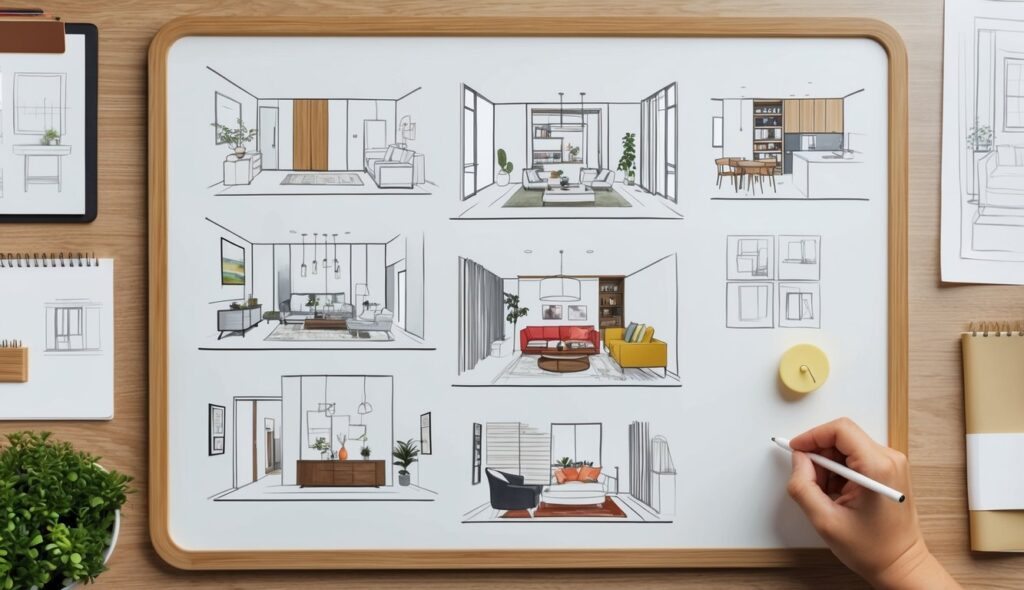Selecting the right paint samples is crucial for achieving the desired aesthetic and functionality in architectural projects.
Remember to repin your favorite images!
Paint samples allow architects to visualize how colors will look on different surfaces and under various lighting conditions.
Using peel-and-stick paint samples, like those reviewed by Engineers and Architects of America, offers an accurate and mess-free way to ensure color accuracy.
When evaluating paint samples, consider the substrate and its interaction with the paint.
Different surfaces may absorb or reflect light differently, affecting the final appearance.
Additionally, high-quality paints generally provide better coverage and durability, reducing the need for multiple coats.
Understanding these factors can help in choosing the right paint for any architectural project.
Lighting plays a significant role in how paint colors are perceived.
It’s important to test paint samples in various lighting conditions, both natural and artificial, to see how they will appear throughout the day.
Choosing the right paint involves not just color selection, but also considering the finish and quality, ensuring the project meets both aesthetic and practical goals.
Understanding Paint Types and Finishes
Choosing the right paint for architectural projects involves understanding various paint finishes and how they interact with different surfaces. This ensures durability, aesthetic appeal, and functionality.
The Importance of Paint Finishes
Paint finishes impact the look and feel of a space. Each finish has its own unique properties.
Matte finishes provide a non-reflective surface, ideal for covering imperfections on ceilings and walls.
Eggshell adds a slight sheen, making it suitable for areas that need durability without too much shine, like living rooms and bedrooms.
Satin finishes offer more shine than eggshell and are highly durable. They work well for high-traffic areas such as hallways and family rooms.
Semi-gloss and high-gloss finishes create a very reflective surface, making them perfect for doors, trim, cabinets, and millwork.
These finishes highlight architectural features but also reveal surface flaws. Properly selecting the finish can significantly enhance the overall design and longevity of the paint.
Selecting Paint for Different Surfaces
Different surfaces require specific types of paint to achieve the best results.
For interior paint, latex and water-based paints are popular due to their quick drying time and ease of cleaning. They are commonly used on walls, ceilings, and trim.
Oil-based paints are more durable and are often chosen for high-traffic areas like trim, doors, and cabinets.
Exterior paint needs to withstand harsh weather conditions.
Oil-based paints provide a durable, weather-resistant surface, while water-based paints are more flexible and resistant to cracking.
Using appropriate primers is crucial to prepare surfaces, ensuring better paint adhesion and durability.
For millwork and cabinetry, semi-gloss and high-gloss finishes are advisable to achieve an elegant and durable look.
Color Considerations for Architectural Spaces
Selecting the right colors for architectural projects involves understanding the impact of hues on spatial dynamics and lighting. Different environments require tailored palettes to enhance both aesthetics and functionality.
Choosing Colors for Different Rooms
For high-traffic areas, like hallways and entryways, durable paint in darker shades can mask dirt and wear.
Living rooms benefit from neutral colors that create a calm base for a variety of decor styles. Select warm undertones to make public spaces feel inviting.
In kitchens, opt for lighter, brighter colors to give a clean and energetic vibe. Whites or soft blues can make the space appear larger.
Bedrooms often need soothing colors like pastels to promote relaxation.
For dining rooms, deep, rich hues can create an intimate ambiance.
Bathrooms should have colors that highlight cleanliness, such as crisp whites or light grays. In offices, use cool tones like blues and greens to enhance focus and productivity.
Navigating Color and Lighting Dynamics
Lighting greatly influences how paint colors appear.
Natural light shifts throughout the day, impacting perceived undertones.
Artificial lighting, whether warm or cool, further alters the look of a room.
Architects should consider daylight exposure when choosing paint colors.
North-facing rooms, which get less light, benefit from warm tones to counteract cool natural light.
South-facing rooms can handle cooler tones due to the abundance of natural light.
Layering different light sources, from overhead fixtures to task lighting, also helps in balancing out colors and tones.
Using a combination of these strategies ensures that the chosen paint colors enhance the architectural elements and meet the client’s needs efficiently.
For more tips, you might find these articles helpful: Tips for Choosing Paint Colors and How to Choose Paint Colors.

